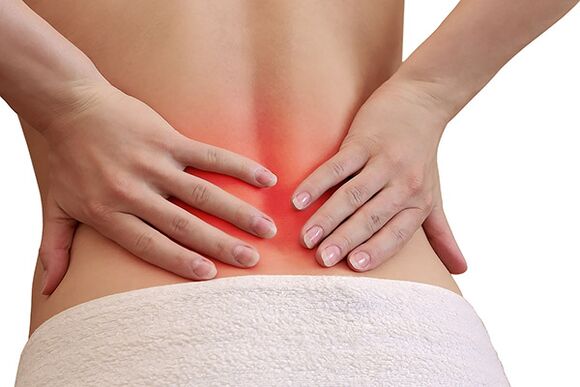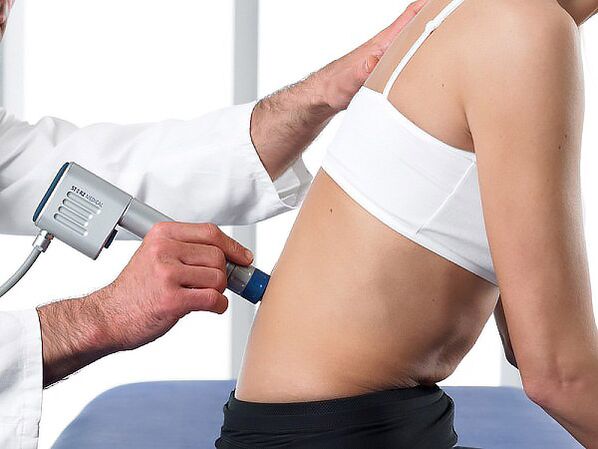Thoracic osteochondrosis is one of the most common diseases of the spine in humans, affecting the intervertebral discs and causing degenerative-dystrophic changes in the spine.
In osteochondrosis, the intervertebral discs lose their elasticity and cannot perform a shock-absorbing function. Discs can become thinner, flake and deform. The pulpal nucleus decreases and the damping function becomes impossible or reduced to a minimum, and the fibrous ring loses its elasticity and gradually collapses, which can lead to the formation of an intervertebral hernia.
Osteochondrosis of the chest causes displacement of the vertebrae and pinching of nerve roots, which affects the functioning of internal organs and limbs.
Due to the fact that the thoracic region is less mobile in its physiological characteristics than the cervical and thoracic regions, thoracic osteochondrosis is much less common.
Thoracic osteochondrosis develops mainly in people over the age of 40, but young people and children can also get it. The cause of the disease may be congenital problems with the spine or poor metabolism.
Symptoms of osteochondrosis of the chest, manifesting at different stages of the disease. What you need to pay attention to in order to diagnose the disease in time and prescribe treatment.

Symptoms of thoracic osteochondrosis
Chest osteochondrosis is often confused with other diseases for which the pathology is called chameleon.
Thoracic osteochondrosis is a disease that develops slowly and at different stages there are special symptoms that you need to pay attention to in order to diagnose the disease in time and start treatment.
There are 4 stages of the disease, the symptoms of thoracic osteochondrosis will vary.
1 stage
The first stage of the disease is characterized by internal fissures of the fibrous ring, which penetrates the pulpal nucleus. Grade 1 osteochondrosis can cause the following symptoms:
- Painful pain in the chest. This is the first sign that changes are taking place in the body. Chest pain with osteochondrosis affects only the spinal area. Unpleasant painful sensations appear after physical exertion, monotonous work or inaction. Often patients attribute such feelings to general fatigue and overexertion, but in fact - this is a reason to consult a doctor;
- Muscle shots in the heart area and small convulsive contractions. As the intervertebral disc begins to deform, this usually causes pinching of small nerve endings and blood vessels. The reason for this may be sharp shooting pains in the chest or convulsions. They pass quickly, but appear after the next load on the spine.
Stage 2
Grade 2 osteochondrosis of the chest is characterized by the appearance of pathologies in the spine, which causes excessive mobility of the vertebrae. The discs lose their previous structure and shape, each vertebra gets the opportunity for poorly controlled movement. This condition can cause the following symptoms:
- There are subluxations of the vertebrae in the chest. Subluxations are accompanied by constant pain, as in cold muscles. The patient temporarily loses his ability to move completely, to turn right and left;
- Pain when walking or inactivity. Chest osteochondrosis pain worsens with long walks or reading a book when the body is in one position.
Stage 3
Grade 3 thoracic osteochondrosis causes more complex changes in the form of rupture of the fibrous ring and exit of the pulpal nucleus, forming intervertebral hernias. These changes cause symptoms:
- Pinched nerve roots. Hernias can cause serious disturbances in the functioning of the body. It all depends on which vertebrae the annular ring is torn between. Problems with the kidneys, liver, gallbladder, digestive tract may occur. If a hernia has formed between the 1st and 2nd vertebrae of the chest, then the hands and fingers may endure or even hurt.
- Spinal cord pinching. Pinching the spinal cord in the spinal canal can lead to irreversible consequences to disability;
- Chest muscle tension. Pathological processes in the spine cause constant tension in the muscles and ligaments that maintain the mobility of the chest;
- The development of kyphosis or scoliosis. Thoracic osteochondrosis can cause pathological changes in the spine in the form of kyphosis or scoliosis. The spine can deform in the affected area and become immobile.
Stage 4
The symptoms of osteochondrosis of the spine in stage 4 are exacerbated, the patient may bend over, be constantly depressed. The patient is constantly worried about pain that has bothered him for a long time. Working capacity decreases, fatigue quickly appears after a little exercise. Osteochondrosis of the thoracic spine stage 4 causes abnormalities in the work of internal organs.
The symptoms of osteochondrosis in men and women are the same, because as soon as there is one or more manifestations of ill health or chest pain, you should seek professional help.
What can cause the development of osteochondrosis of the chest. What moments in a person's life should be considered in order to avoid the symptoms and treatment of this dangerous disease.
Causes of osteochondrosis of the chest
The main reason for the development of the pathology is the lack of exercise, due to which the muscles and ligaments that support the work of the chest area weaken and the spine experiences an increased load.
But in addition to poor physical shape, the reasons may be:
- Hereditary and congenital problems with the spine. Spinal problems can be from birth. The baby's birth trauma (difficult birth or medical errors) and genetic predisposition to pathology contribute to the onset of the disease. If the parents had osteochondrosis, then under favorable conditions the child may also develop this disease.
- Improper posture. Posture should be monitored from an early age. School-age children may be prone to scoliosis, which will later develop into osteochondrosis and other changes in the spine. Adults should also not forget about proper posture. Chest osteochondrosis occurs if you do not pay attention to the position of the spine during work, walking, reading and just sitting at the computer. It is important to always keep your back straight, not to lean forward or backward when walking, avoid long poses in a bent position. How to maintain proper posture, you can ask on the Internet resources by looking at the photos from the training.
- Nervous tension. Nervous strains always have a negative effect on people's health and can cause serious illness. Stressful situations can cause muscle stiffness and poor metabolism. Therefore, it is worth reconsidering your attitude to certain aspects of life and to protect yourself as much as possible from provoking factors.
- Traumatic injuries. Injuries to the back and chest can cause osteochondrosis. It is important to treat even minor injuries in time, while not allowing self-medication, but always consult a specialist.
- Wearing heavy weights and high heels. It is a well-known fact that every centimeter of heels loads the spine from 7 to 10 kilograms. If a woman already has a predisposition to spinal diseases, then high-heeled shoes should be abandoned or wearing such shoes should be kept to a minimum. Pregnant women are at risk because in the last months of pregnancy the load on the spine is very large and uneven. After birth, newborn mothers should visit a doctor and undergo an examination of the spine to prevent the development of pathology in time.
- Metabolic disease. Degenerative changes in the intervertebral discs are very often caused by a lack of nutrients, which is caused by a violation of metabolic processes. To normalize the metabolism, you must first consult a doctor and find out what is the cause of such disorders.
- Infections and hypothermia. Improper treatment of infectious diseases in the body can adversely affect not only the chest but also the work of other vital organs. Hypothermia can cause inflammation of the nerve roots and muscles that support the work of the thoracic spine.

What methods are used to treat osteochondrosis of the chest. What should be done to relieve symptoms and treat the disease.
Treatment of osteochondrosis of the chest
The treatment of osteochondrosis of the chest should be carried out exclusively under the supervision of an experienced specialist after a complete examination and diagnosis of the degree of development of the disease.
The symptoms and treatment of osteochondrosis of the thoracic spine are determined by a neurologist, in extreme cases the treatment is joined by a surgeon and a neurosurgeon.
To treat the disease more effectively and quickly in the early stages, but for this you need to consult a doctor in time. It is important to understand that the longer the pathology develops, the more consequences will have to be eliminated, and this will affect the financial costs and time of treatment.
With timely access to specialists it is possible to avoid deformity of the spine with the help of vitamins and physical activity. To do this, the doctor will issue a special brochure where the photo will show all the exercises. It is important to look at the photo immediately and ask the doctor any questions about proper performance. The first session is best conducted under the supervision of a physician.
Treatment of osteochondrosis of the breast with drugs
First, after diagnosing the disease, the doctor prescribes treatment that eliminates the symptoms of thoracic osteochondrosis.
First, the neurologist eliminates the pain syndrome with medication and then moves on to direct treatment.
Drugs used for osteochondrosis:
- Non-steroidal anti-inflammatory drugs. With the help of anti-inflammatory drugs relieves chest pain.
- Diuretics. Diuretics are prescribed when there is swelling of the nerve roots. Diuretics relieve swelling, thus improving the blood supply to the affected areas.
- Vitamins for nourishing nerve tissue.
- Chondroprotectors. With the help of chondroprotectors try to restore the fibrous ring of the intervertebral disc.
- Antispasmodics relieve spasms of tense muscles and increase the mobility of the chest, thus reducing pain syndromes.
The symptoms and treatment of thoracic osteochondrosis do not always bring a positive result, therefore, if drug therapy has not affected, then the doctor will suggest a surgical solution to the problem.
Physiotherapy for osteochondrosis of the chest
Physiotherapy for osteochondrosis of the chest is an effective method of dealing with the disease.
This is due to the fact that during such procedures the drugs are injected exclusively in the affected areas of the spine.
Physiotherapy relieves pain, inflammation and tension in muscle mass and ligaments.
Physiotherapy sessions should only be performed by an experienced physiotherapist. Properly performed procedures will lead to the desired result and speed up the healing process.
Acupuncture for osteochondrosis of the chest
This Chinese method of treating many diseases is based on the introduction of special needles in the affected areas.
Through acupuncture, they tone the muscles and return them to their previous functions. The needles are placed strictly according to the growth of certain muscles, so you should not do this procedure at home, guided by a photo or video from the Internet.
The number of procedures is determined by the specialist, based on the degree of tightening of muscle fibers. With a specially trained master, acupuncture will be painless and will restore muscle tone in a short time.































